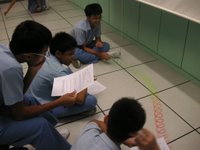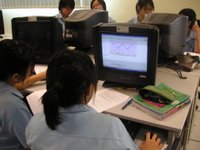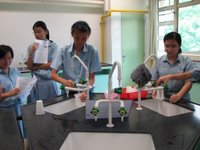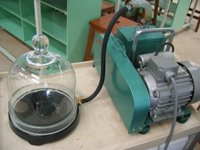Action Research readings and resources (1)
1. Action Research (AR) process and practice
http://www.bamaed.ua.edu/~kstaples/Action%20Res.HTM
2. Additional reading on AR at edu.MALL sitel
http://www.moe.gov.sg/edumall/rd/rdmap.htm
3. Online statistical functions for data analysis
http://www.fon.hum.uva.nl/Service/Statistics.html
Thursday, September 21, 2006
Wednesday, September 13, 2006
 13 Sep 2006
13 Sep 2006I conducted the 1st lesson on "General Wave Properties" with kind assistance from Elsie (ETD), Wan Eng and Peici in facilitating the students' activities. Some learning points:
1. Activity A1: group use of slinky to visualise transverse waves
- need close teacher supervision and facilitation
- some students prefer to have "fun" rather than focus on task given
- students are not used to describing observations of physical phenomena - in terms of language and vocabulary use
 2. Activity A2: pair work on PC using applet via internet to investigate graphical representation for transverse waves
2. Activity A2: pair work on PC using applet via internet to investigate graphical representation for transverse waves- close teacher supervision also required
- internet access may be slow on some PCs
- students have difficulty with concept of displacement (although concept was taught under "Kinematics") - prior discussion would be helpful.
- plotting a displacement-time graph also poses some difficulty - a guided approach to use numerical values to plot such a graph may be useful
- comparing the differences between displacement-time and displacement-position graphs may need more guided questions to bring out relevant features
- more capable students prefer individual PC work - they are more independent.
Monday, September 11, 2006
11 Sep 2006
Planning inquiry-based lesson on "General Wave Properties" with a focus on understanding of graph representation of transverse and longitudinal waves.
Tentative ideas:
Class: 308; Venue: Computer Lab 3;
Resources: slinky springs, web-based applets -
http://www.ngsir.netfirms.com/englishhtm/Lwave.htm
http://www.ngsir.netfirms.com/englishhtm/TwaveA.htm
- powerful simulations to help students visualise wave motion graphical & representation
Activities:
1. introduction to wave properties and terms
2. group work - handle slinky springs to create transverse & longitudinal waves
3. pair work - explore features of waves using web-based applets with guided inquiry-based worksheet.
Planning inquiry-based lesson on "General Wave Properties" with a focus on understanding of graph representation of transverse and longitudinal waves.
Tentative ideas:
Class: 308; Venue: Computer Lab 3;
Resources: slinky springs, web-based applets -
http://www.ngsir.netfirms.com/englishhtm/Lwave.htm
http://www.ngsir.netfirms.com/englishhtm/TwaveA.htm
- powerful simulations to help students visualise wave motion graphical & representation
Activities:
1. introduction to wave properties and terms
2. group work - handle slinky springs to create transverse & longitudinal waves
3. pair work - explore features of waves using web-based applets with guided inquiry-based worksheet.
Friday, September 08, 2006
Internet resources (2)
These are some sites featuring common physics preconceptions/misconceptions:
1. Recurring Science Misconceptions in K-6 Textbooks (William J. Beaty)
http://www.amasci.com/miscon/miscon4.html
2. Misconceptions spread by K-6 Textbooks on Electricity (William J. Beaty)
http://amasci.com/miscon/elect.html
3. Clarifications of certain Physics misconceptions or preconceptions using videoclips (Xinmin Online!)
http://www.xinminss.moe.edu.sg:1285/physics/misconceptions/physicsmisconceptions.htm
These are some sites featuring common physics preconceptions/misconceptions:
1. Recurring Science Misconceptions in K-6 Textbooks (William J. Beaty)
http://www.amasci.com/miscon/miscon4.html
2. Misconceptions spread by K-6 Textbooks on Electricity (William J. Beaty)
http://amasci.com/miscon/elect.html
3. Clarifications of certain Physics misconceptions or preconceptions using videoclips (Xinmin Online!)
http://www.xinminss.moe.edu.sg:1285/physics/misconceptions/physicsmisconceptions.htm
23 Aug 2006
First Contact Project Meeting (LEAD IT @ Schools project) between ETOs Alexis & Elsie and school (JL, Mr Lau and principal) to
1. establish short and long term goals
2. identify measurable outcomes &
3. surface possible implementation issues and support the school might need
through the use of a LEAD IT Workplan prepared for the project.
First Contact Project Meeting (LEAD IT @ Schools project) between ETOs Alexis & Elsie and school (JL, Mr Lau and principal) to
1. establish short and long term goals
2. identify measurable outcomes &
3. surface possible implementation issues and support the school might need
through the use of a LEAD IT Workplan prepared for the project.
4 August 2006
JL worked with Wee Yap (trainee) to design and implement an inquiry-based worksheet on Convection (under Transfer of thermal energy). A video clip on a a rectangular tube filled with water with ink added at the top was shown. On the worksheet, students in groups recorded what they observed, and discussed the physical basis of their observations. They were asked to predict what may happen if a factor was changed in the experiment. A subsequent lesson was used for discussions on common misconceptions and inaccuracies in descriptions and reasoning.
JL worked with Wee Yap (trainee) to design and implement an inquiry-based worksheet on Convection (under Transfer of thermal energy). A video clip on a a rectangular tube filled with water with ink added at the top was shown. On the worksheet, students in groups recorded what they observed, and discussed the physical basis of their observations. They were asked to predict what may happen if a factor was changed in the experiment. A subsequent lesson was used for discussions on common misconceptions and inaccuracies in descriptions and reasoning.
31 July 2006
JL worked with Wee Yap (trainee) to design and implement an inquiry-based worksheet on Conduction (in the topic Transfer of thermal energy). A video clip on a bunsen flame heating a piece of paper (half wrapped over a plastic bottle and half wrapped over an aluminium can) was shown. On the worksheet, students predicted what would happen, explained their rationale, observed what actually happened and wrote down their reasonings. A subsequent lesson was used for discussions on common misconceptions and inaccuracies in descriptions.
JL worked with Wee Yap (trainee) to design and implement an inquiry-based worksheet on Conduction (in the topic Transfer of thermal energy). A video clip on a bunsen flame heating a piece of paper (half wrapped over a plastic bottle and half wrapped over an aluminium can) was shown. On the worksheet, students predicted what would happen, explained their rationale, observed what actually happened and wrote down their reasonings. A subsequent lesson was used for discussions on common misconceptions and inaccuracies in descriptions.
Thursday, September 07, 2006
 28 June 2006
28 June 2006JL conducted lessons on pressure for 3E Pure Physics. Students moved to different stations to carry out simple experiments and make observations. Two of the stations with inquiry-based worksheets:
1. pressure changes in a balloon being pumped.
2. forces acting on an inverted water-filled cup covered with a piece of transparency.
Students wrote down their ideas of the physical changes with the help of free-body diagrams. A subsequent lesson was devoted to discussion of common misconceptions.
Wednesday, September 06, 2006
Internet resources (1)
1. Models of inquiry-based learning - some general references on various models of inquiry
http://www.teach-nology.com/currenttrends/inquiry/
2. Constructivism & the Five Es - in the Biological Science Curriculum Study (BSCS) model, the constructivistic learning process is explained by employing five "E"'s: Engage, Explore, Explain, Elaborate and Evaluate.
http://www.miamisci.org/ph/lpintro5e.html
3. Levels of inquiry: Hierarchies of pedagogical practices and inquiry processes - this paper gives a comprehensive discussion of various types of inquiry-based lessons, including discovery learning, interactive demonstration, inquiry lesson, inquiry lab & hypothetical inquiry. The "sidebar stories" give clear illustrations of inquiry-based lessons and questioning techniques. A good read.
http://www.phy.ilstu.edu/pte/311content/effective/levels_of_inquiry.pdf - pdf file of the paper
www.phy.ilstu.edu/pte/311content/inquiry/levels_of_inquiry.ppt - powerpoint of key ideas
4. Physics by Inquiry (PbI) approach - by L.C. McDermott & Physics Education Group at University of Washington
http://www.phys.washington.edu/groups/peg/pbi.html
1. Models of inquiry-based learning - some general references on various models of inquiry
http://www.teach-nology.com/currenttrends/inquiry/
2. Constructivism & the Five Es - in the Biological Science Curriculum Study (BSCS) model, the constructivistic learning process is explained by employing five "E"'s: Engage, Explore, Explain, Elaborate and Evaluate.
http://www.miamisci.org/ph/lpintro5e.html
3. Levels of inquiry: Hierarchies of pedagogical practices and inquiry processes - this paper gives a comprehensive discussion of various types of inquiry-based lessons, including discovery learning, interactive demonstration, inquiry lesson, inquiry lab & hypothetical inquiry. The "sidebar stories" give clear illustrations of inquiry-based lessons and questioning techniques. A good read.
http://www.phy.ilstu.edu/pte/311content/effective/levels_of_inquiry.pdf - pdf file of the paper
www.phy.ilstu.edu/pte/311content/inquiry/levels_of_inquiry.ppt - powerpoint of key ideas
4. Physics by Inquiry (PbI) approach - by L.C. McDermott & Physics Education Group at University of Washington
http://www.phys.washington.edu/groups/peg/pbi.html
 10 May 2006
10 May 2006JL conducted lessons for 3E Pure Physics on Pressure. Video clips were used showing experiments using a vacuum pump and a bell jar to demonstrate the effect of pressure changes on:
1. a partially blown balloon,
2. a partially "crushed" empty plastic bottle and
3. a beaker of hot water.
On given worksheets, students described what they observe via the video clips and attempted to explain the phenomena based on their knowledge of pressure concepts. A subsequent lesson discussion on concepts of pressure differences and effects was done.
Subscribe to:
Posts (Atom)